Kitchen island lighting ideas – 20 ways to make it functional and fabulous
These kitchen island lighting ideas will ensure it’s practical for food prep and put the focus on a great design feature

Lara Sargent
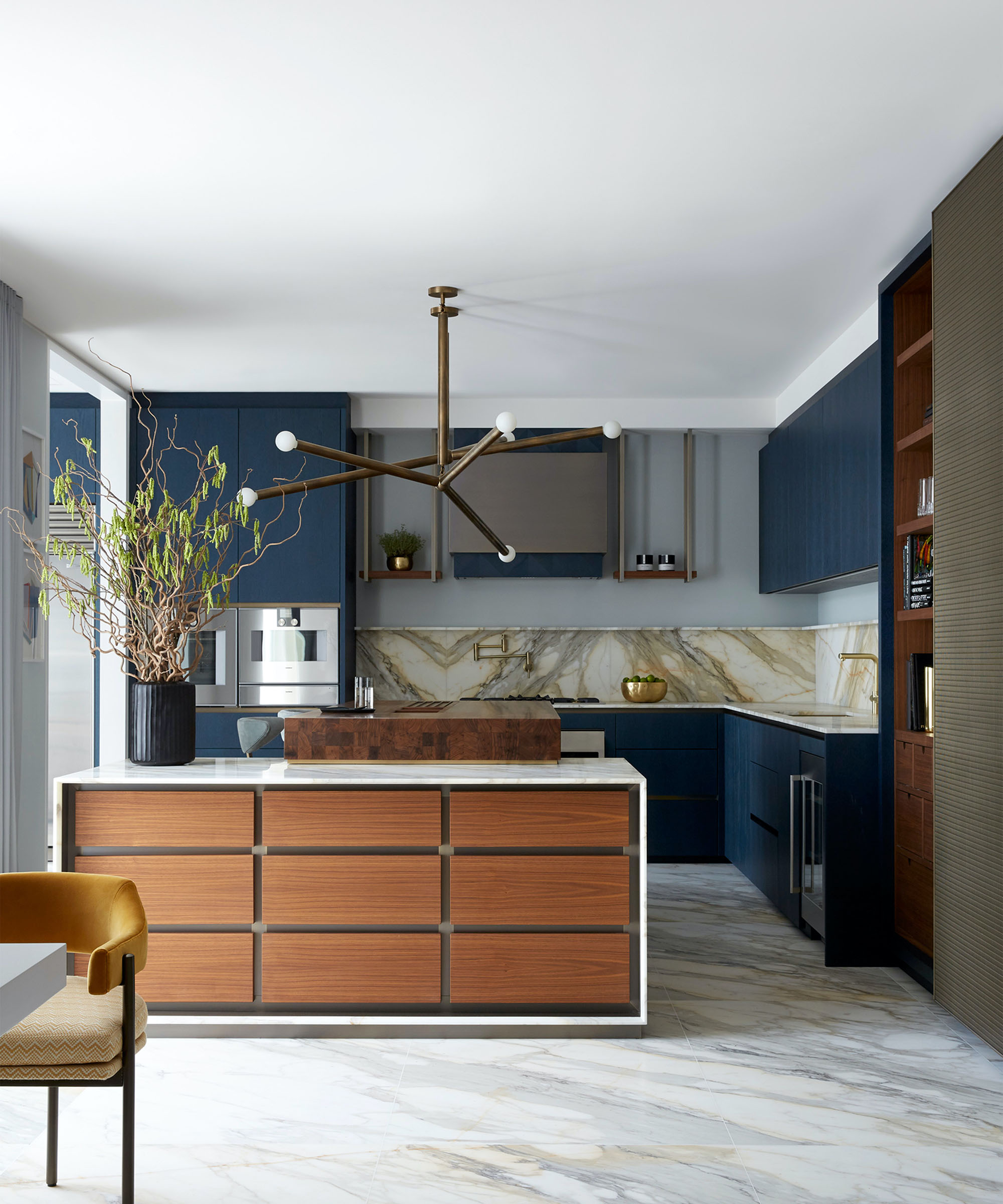
Kitchen island lighting ideas draw the eye to this centerpiece of the room, and make a stylish statement in their own right. Alone, they can even make a quite pared-back, ordinary island the focal point of a home.
Like all kitchen lighting ideas, the illumination for an island is crucial in aesthetic terms plus it needs to contribute to providing the right level of illumination for all the room’s functions. For food preparation, cooking, and serving, well illuminated countertops are essential, but kitchen lighting must also be adjustable to create different moods for the room’s other activities.
Here, we’ve put together kitchen island lighting ideas that are showstoppers in their own right, highly functional and that offer the versatility that’s crucial to the success of the lighting design along with advice from the experts.
Kitchen island lighting ideas
Kitchen island ideas need to fulfill a range of needs. Islands are ‘used for both cooking and food preparation, as well as entertaining and bringing the family together’, says Niki Wright, founder of Lights & Lamps. And kitchen island lighting ideas are ‘therefore key for creating the right warmth and atmosphere, that works right from early morning cups of coffee through to intimate late night glasses of wine’.
Style matters as well as practical considerations. ‘The kitchen island is where design and function meet,’ notes Sam Neuman, founder of Home Lighting Ideas. ‘Kitchen islands should be enjoyable yet functional workstations.
'Food preparation requires balanced light to reveal the detail of ingredients and fine chopping. While conversely, low to no light is required during meals to mask the evidence of its creation. In between times, an island is the design feature to create focus in the space and to invite conversation.’
1. Create a mix and match vintage look

Let your imagination run a little wild with kitchen island lighting. Plan kitchen lighting that’s simple and unobtrusive with built-in spotlights then create a focal point with the lighting over the island.
Design expertise in your inbox – from inspiring decorating ideas and beautiful celebrity homes to practical gardening advice and shopping round-ups.
‘Spider pendant lights are a great way to create a statement in your kitchen as they have multiple flexes which are ideal for wide expanses,’ says Marketa Rypacek, managing director of Industville. ‘You can choose what distance to suspend each flex and then loop or fix to the ceiling with the option of off-setting from the central rose. They are versatile, too, so can be used either with bare lamps to showcase vintage-style bulbs or with decorative shades. You could even do a combination of the two to create something unique.’
You don’t need high ceilings for a spider pendant to work for kitchen islands as you can choose what distance to suspend each flex and alter the length, too.
2. Hang pendants at the correct height

A row of pendants suspended above a kitchen island is a foolproof way to illuminate this central kitchen fixture. Kitchen ceiling lighting ideas can add an extra special decorative touch, (be it with glass or metal shades or sticking to bare bulbs) and provide effective task lighting at the same time. It is crucial, though, that pendants are hung at the right height.
‘Pendants should hang 12 to 20in (30 to 51cm) below an eight-foot (2.4m) ceiling,’ explains design director of the eponymous company Tom Howley. ‘For each additional foot (0.3m) of ceiling height, add three inches (8cm). For example, for a nine-foot (2.7m) ceiling, the pendant should hang 15 to 23in (38 to 58cm) below. Keep the pendants an equal distance apart from each to promote a sense of symmetry and keep the end pendants about six inches (15cm) inside the edge of the island.’
Dimmer switches are a handy feature, too: turn up the lighting when cooking and prepping food and dim when dining and socializing.
‘Task lighting is ideally situated to the areas where you need to see clearly, such as when you’re preparing food or need to read recipes or cooking instructions,’ adds Tom. ‘Good, strategically placed, pendant lighting that can be operated independently to your main feature lighting is great here.’
3. Keep it minimal
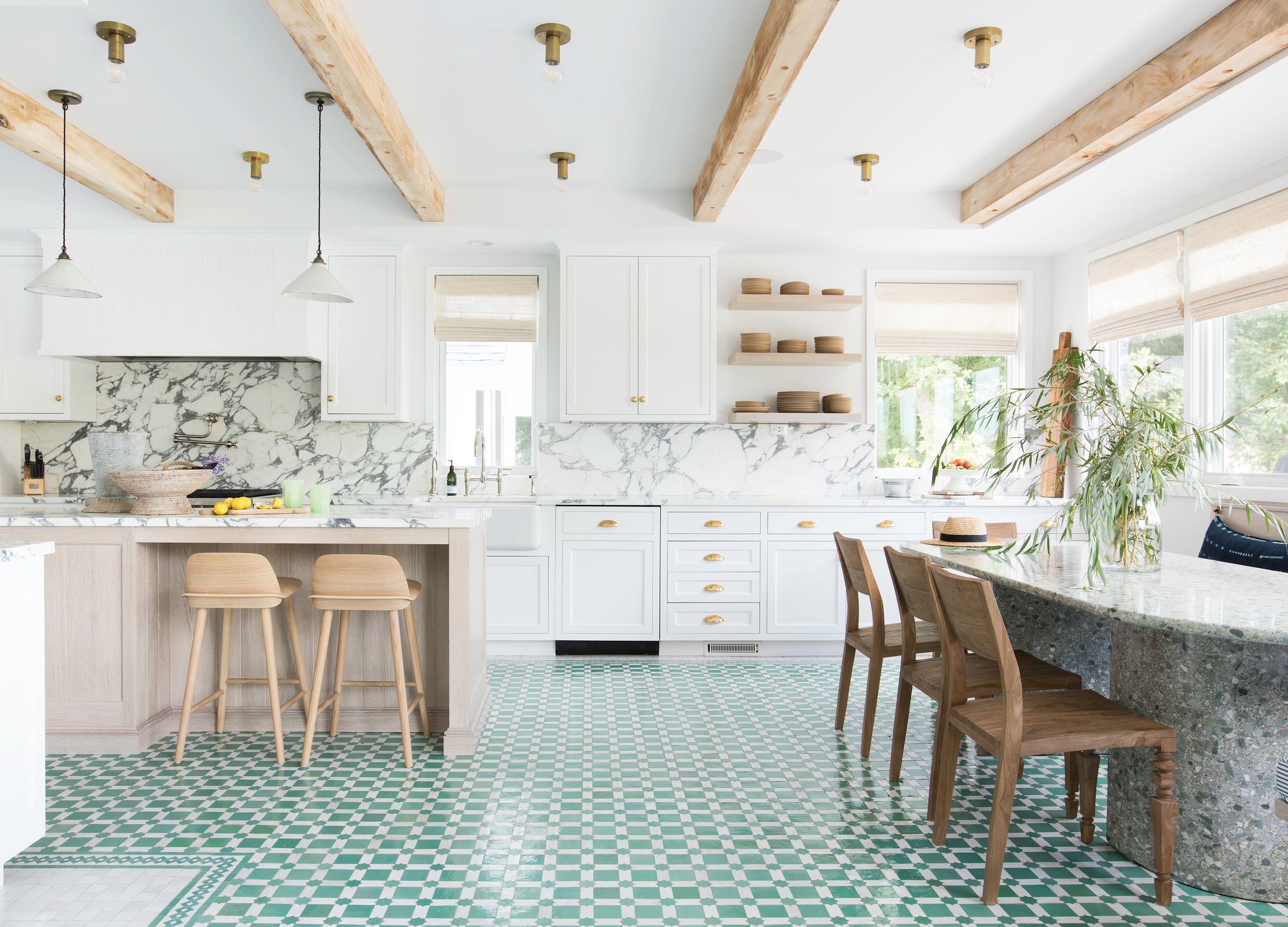
Big is not always better when it comes to kitchen island lighting ideas – in fact, unobtrusive pendants are a good choice if you don’t want to overwhelm a design. Perhaps you have installed statement shades over a separate dining table, in which case you don’t want kitchen island lighting to create a busy style clash.
‘Keep pendant lights subtle and not too overpowering, even though the urge to really make your mark with these is hard to resist,” says deVOL’s creative director, Helen Parker. ‘Don’t be set on the three lights over an island combination – try to be less obvious and go for simple, understated and beautiful.’
Jersey Shore interior designer Nicole Cohen, agrees. ‘I love to play with scale over kitchen islands. In this kitchen we designed in Jersey Shore, we chose deVOL pendants that were smaller. I didn’t want anything too big since we already had lighting all over. My goal was to select lighting that was minimal and chic without overwhelming the space.’
4. Layer with wall lights
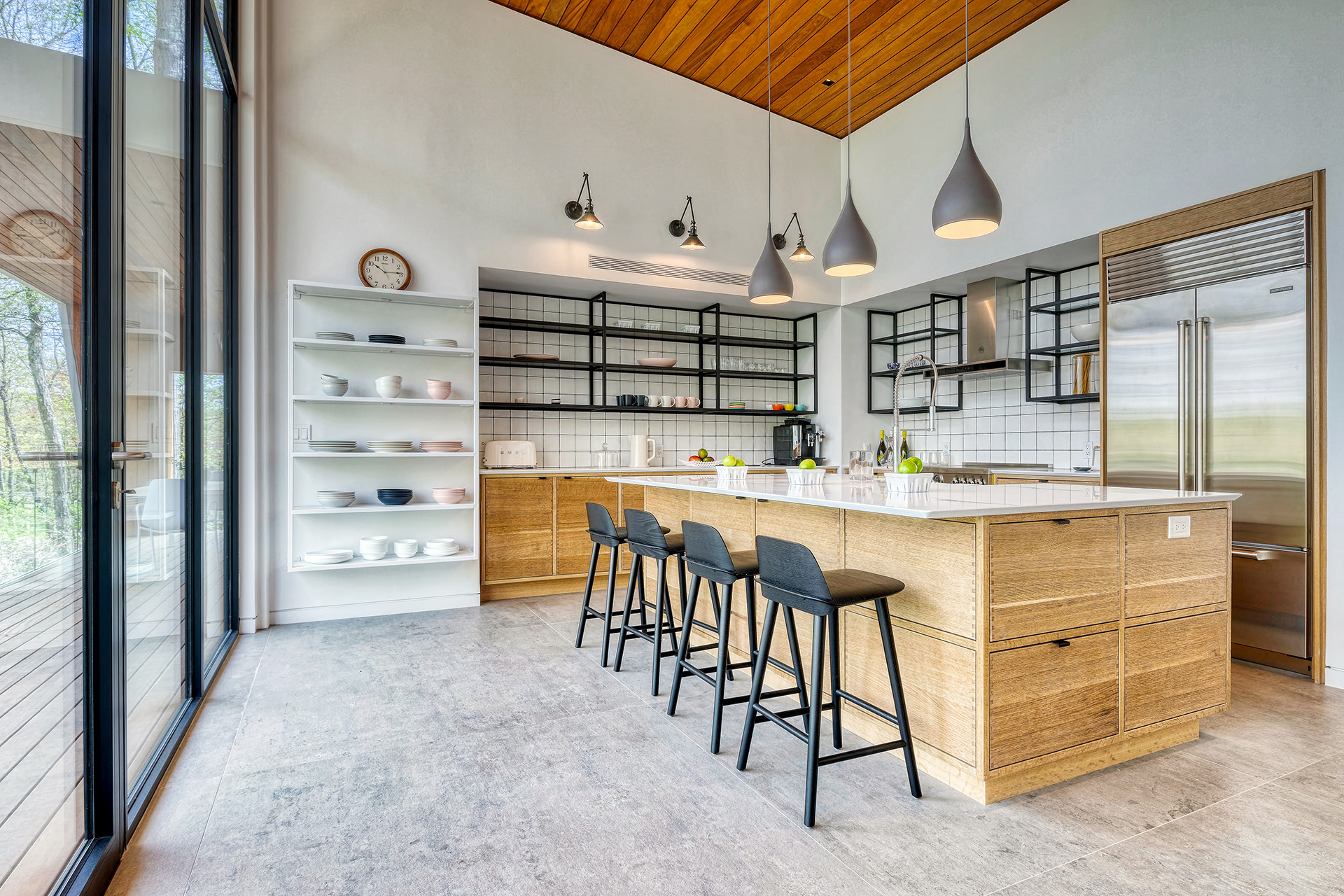
Layering a lighting design is one of the best ways to create atmosphere and increase functionality in a kitchen. If you are opting for a row of pendants over the island, try mixing with kitchen wall lights instead of simply using ceiling fixtures.
‘I would always recommend wall lights in a kitchen,’ says Helen Parker. ‘They are a great way of mixing up the feel of a room; they seem to create a softer light and really give character to a room. A little pool of light in a dark corner is the perfect way to create lovely little spots in a room.’
In this kitchen by New York-based Hudson Design, the adjustable wall lights complement the pendants over the island, and can be rotated upwards to create an alternative, ambient mood for entertaining.
5. Commission a bespoke light

If you have nailed the functionality of your lighting and assessed how much light a kitchen needs, then why not elevate the island with a bespoke light, just like a piece of art. Choose a light to reflect your personality and overall design aesthetic, be it an oversized, vintage chandelier, a contemporary showstopper or a colorful design.
‘Kitchens are the heart of the home and used for far more than just culinary purposes,’ says Katie Glaister, co-founder of K&H Design. ‘Our clients, who are art collectors, wanted more than functional lighting for their kitchen island – they wanted a work of art. Margit Wittig does this brilliantly with her combination of colorful, resin pieces, glass jewels and metal finishes. The burst of color from the pendant reflects off the Pyrolave island countertop to create a real showstopper.’
6. Soften with natural materials

One of the factors in choosing kitchen lighting is the type of material you select – and that includes in the case of for kitchen island lights. This two-tier, island unit has two distinct zones: a main, raised area for cooking and preparing food and a lower, stepped section for dining. To create an informal sense of intimacy at the eating end of the island, an oversized, wooden shade becomes a focal point. The curved, slatted pendant allows light to filter through and softens the functional lines of the kitchen – it’s a clever yet simple design tactic which enhances the dual nature of the island unit.
‘Changing the lights over your kitchen island can have a huge impact on both the brightness level and the character of the room,’ says Kassin Adelman, founder & CEO of IDF Studio based in San Francisco Bay. ‘If you want a warm, rustic feel, go with a woven, ceramic or metal shade with some patina; the light will cast downwards for a soft, directional glow. If you want airy and open, look for pendants in a transparent or milk glass that let off a lot of light and will brighten the whole room. For an edgier vibe, try a sleek, linear fixture, oversized dome pendant or a large-scale chandelier, then pair with dimmable LEDs so you can create the right mood.’
7. Opt for a striking silhouette
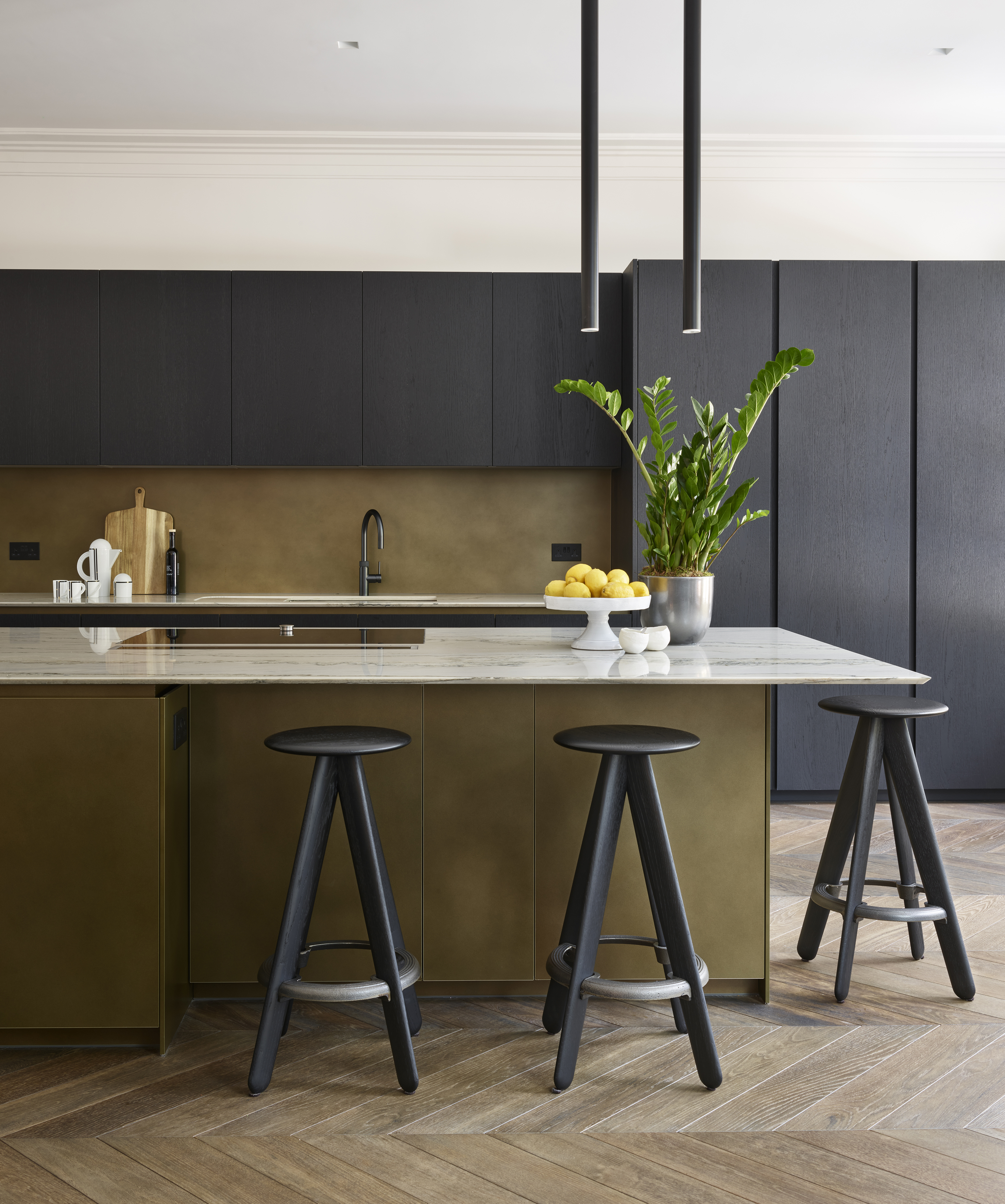
Sometimes less is more and the striking silhouette of these slim LED lights (from luxe Italian brand Boffi) suspended over one end of the kitchen island proves just that. The black oak kitchen furniture is the perfect backdrop to modern kitchen lighting like these tubular, aluminum LOP pendants (an acronym of led organ pipe) and offer changeable lengths according to ceiling height, with the LED light diffuser positioned at the far end of the body.
‘The tubular lights offer both task and ambient lighting,’ says Richard Atkins, managing director of DesignSpace London. ‘They were chosen to create a feature within the room and were positioned over the end of the island which acts as an L-shaped breakfast bar. The contemporary linear design perfectly complements the vertical lines of the cabinet doors.’
8. Choose built-in barely there lighting

In small kitchens or kitchens with low ceilings, recessed lighting over an island is a brilliant solution. Perhaps you have an amazing views from your kitchen windows and you wish to keep these uninterrupted. Either way, built-in spots are slick, unobtrusive and can provide bright, task lighting for a kitchen island, with the option of fitting a dimmer switch.
‘Recessed lighting is a great solution for kitchens with low ceilings or in places where you just don’t want your lights to be the main feature,’ says Andre Kazimierski, CEO of Improovy Painters in Hinsdale, Illinois. ‘In this case, the lights would be built into the ceiling so that they don’t protrude at all – perfect for bright LED bulbs.’
David Lee, founder and CEO of Inyouths LED Mirrors agrees. ‘Recessed lights can be directed towards the island’s center to create a focal point – it can also help to create a more evenly lit space as well as reduce glare on surfaces. Under-cabinet lighting can also illuminate the countertops and backsplashes on either side of the island; this is a great way to add interest and functionality to the kitchen island.’
In this kitchen by Liz Walton Home, a luxury interior design firm in Phoenixville, Pennsylvania, the island is illuminated by 2in circular, LED recessed lights to achieve a clean, no-fuss look without sacrificing function. ‘We were working with low ceilings,’ explains Liz, ‘and we did not want to obstruct the views into the adjacent rooms. We loved the roof lines in the dining room and felt pendants would distract from the beautiful, natural light coming from that space.’
9. Follow an L-shaped line

The L-shaped kitchen island with seating forms the heart of this room, so it was crucial to illuminate every side. The run of black granite worktops are illuminated from above by a neat row of pendant lights hewn from solid alabaster – when lit, the alabaster shades offer a gorgeous diffused light and echo the veined texture of the surfaces below. The dining booth is lit from above by a roof light which doesn’t upstage the surrounding delicate pendants.
‘The space between each pendant will depend on the size of the island and the size of the pendants,’ adds Richard Moore, design director of Martin Moore. ‘The entire surface area of the island should be illuminated and there should be an overall look of symmetry.’
10. Use clear glass in an open-plan room

Open-plan kitchens work really well harnessing a calm, neutral color palette and traditional materials like glass and stainless steel – especially in a lofty old schoolhouse like this one in the centre of busy, bustling Brixton in London.
An existing Bulthaup stainless steel island was kept in place and gave the space a slightly edgy, industrial look that is perfect for this room, which was once the schoolgirls’ dining hall. Paired with a mix of open-plan shelving and painted Shaker cabinets, the island is lit from above by simple, vintage-style glass pendants that don’t compete with the interesting surroundings. The result is cool, contemporary and sympathetically designed to make the most of this important building.
11. Make a modern statement
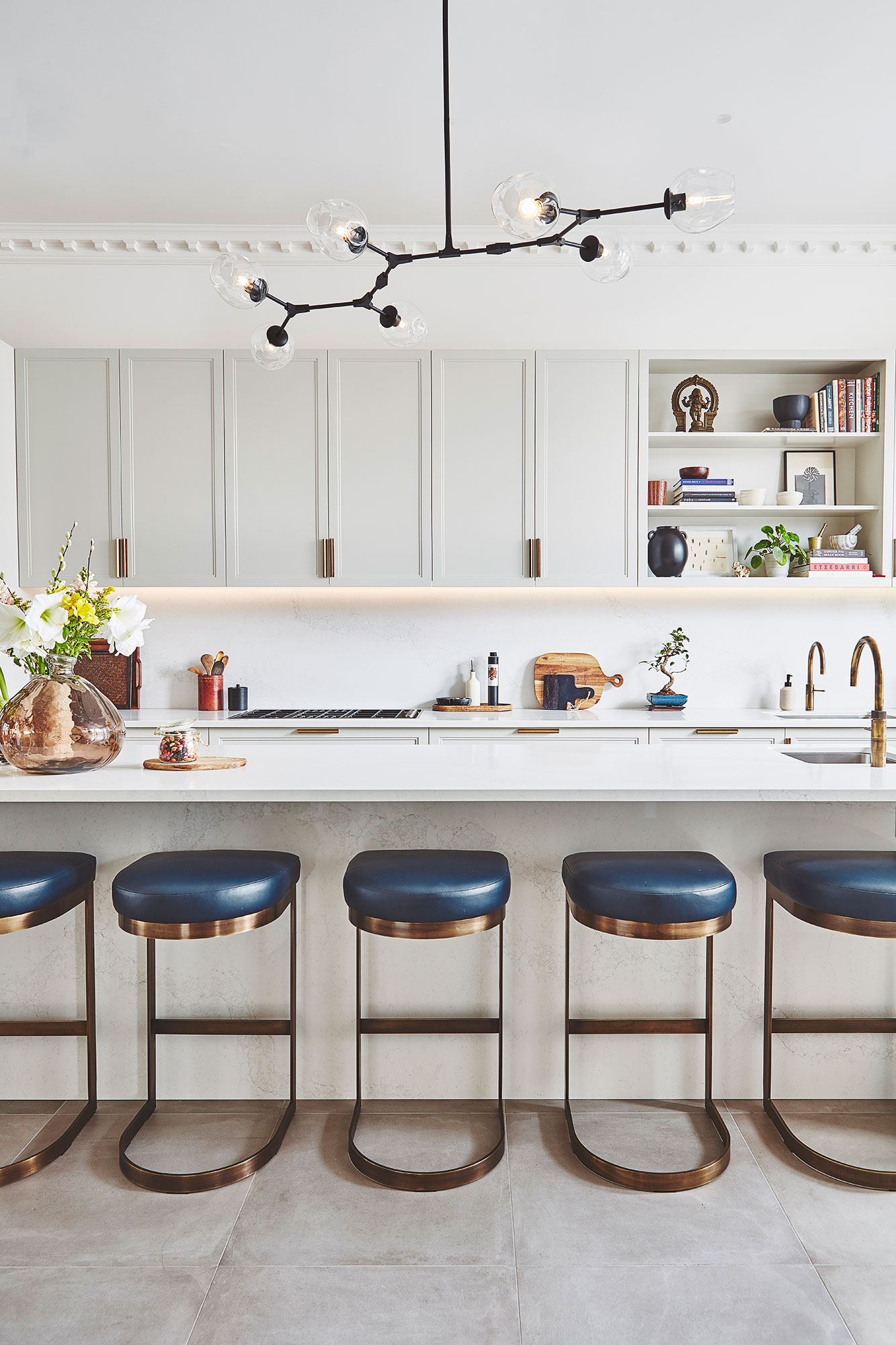
In a contemporary kitchen, with sleek lines and an abundance of white, make a statement with your kitchen island lighting ideas.
Continue the clean lines of the space with modern lighting, such as a bold pendant in a black steel, to make sure your island has all the impact possible.
'Hanging a single pendant over an island can make a bold statement within a scheme,' comments Jamie Blake, creative director of Blakes London.
'In a space such as this, where the ceiling heights are generous, hanging a single oversized pendant over the island draws the eye upwards, bringing the elegant Georgian coving into focus and offering the eye a further point of interest.'
By choosing a pendant that stretches out widely and incorporates multiple bulbs, you ensure that the whole width of the island will be lit; perfect for ensuring both cooking areas and your chosen kitchen island seating ideas are well illuminated.
12. Choose a linear style
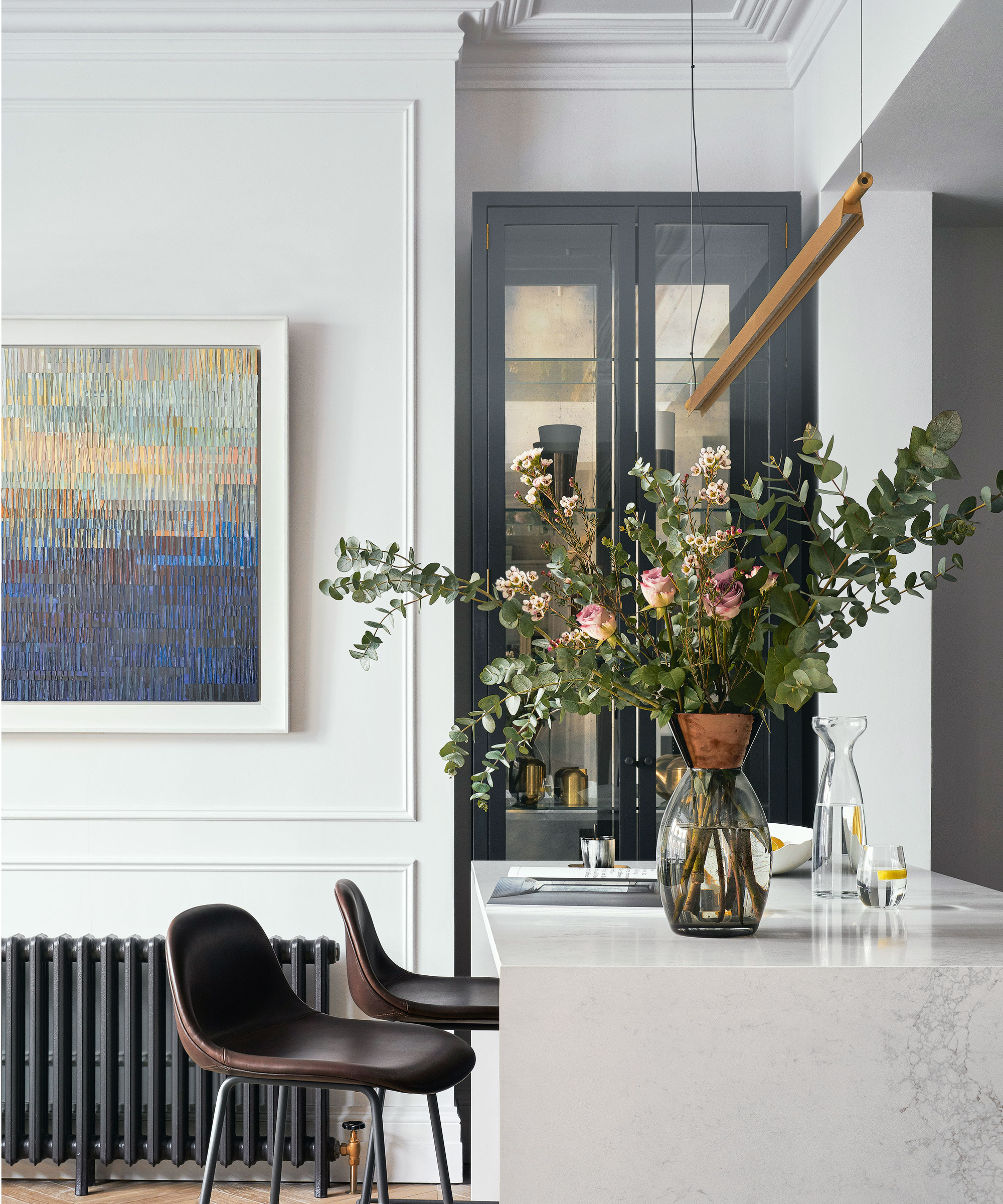
Photography/Davide Lovatti
Another wonderful route for a modern scheme is a linear kitchen island lighting solution. The linear style is especially powerful above a relatively narrow island, as it keeps proportions feeling even, and adds a sleek look to any breakfast bar ideas you are considering.
This is the Compendium Suspension Light by Daniel Rybakken for Viaduct and includes a diffused LED light, meaning not only will the bulbs last, but the light will be dispersed evenly. While this option is available in black and aluminum, opting for a brass finish will add warmth to a contemporary space.
13. Install the unexpected
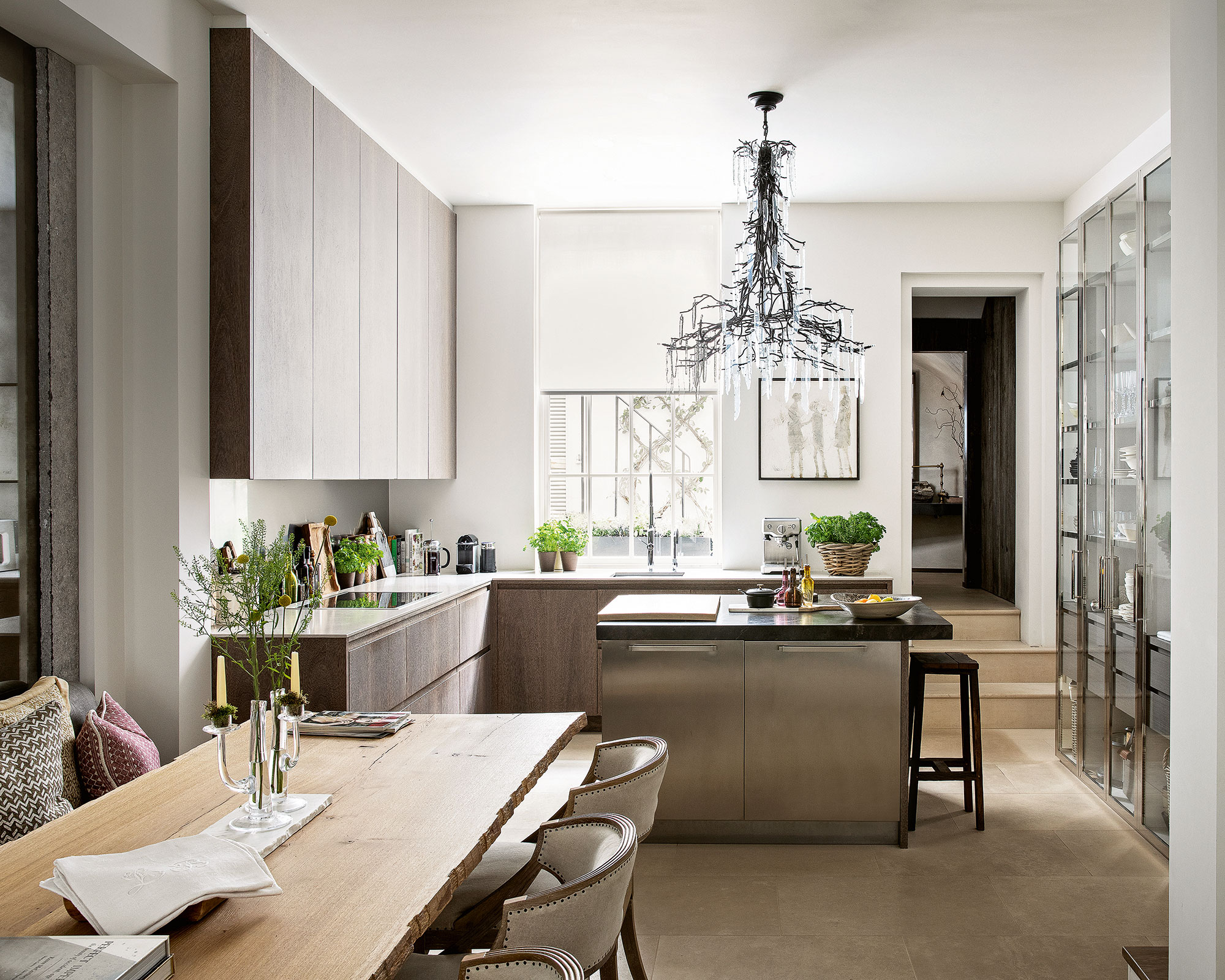
Photography/Paul Raeside
Chandeliers are most often associated with grand staircases, entrance halls and formal entertaining spaces. However, there are no rules against adding one to your kitchen island lighting ideas list.
Install an elaborate chandelier above your island to make the work space a focal point and conversation starter.
Do be aware that, depending on which style you choose, there may be multiple components which could collect dust. Since you obviously don't want dust in your cooking, either choose a more minimal chandelier or make sure to have a quick dust before you begin preparing any food.
14. Light up the rainbow
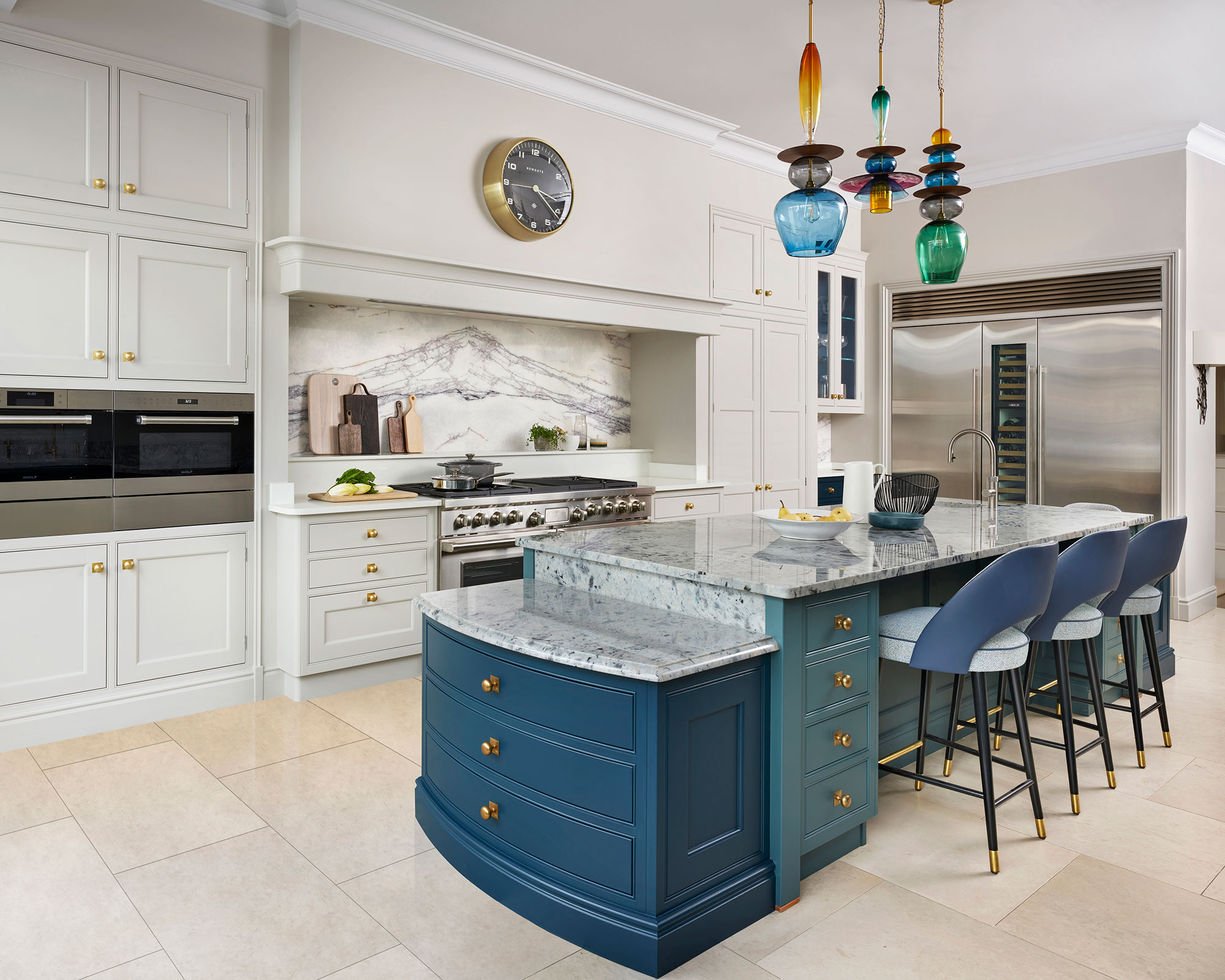
A new trend in kitchen island lighting ideas is the use of color.
'Currently, there is a focus on character lighting; large pendant lights above the island are very popular, helping to introduce color and a decorative touch to the kitchen,' notes Richard Moore, design director at Martin Moore. 'In lofty rooms, pendant lighting also help to draw the focus downwards towards the island.'
When planning kitchen lighting with color, integrate shades from your kitchen cabinet ideas to create cohesion. Once this is in there, have fun with adding unexpected pops of other hues.
15. Look to traditional materials
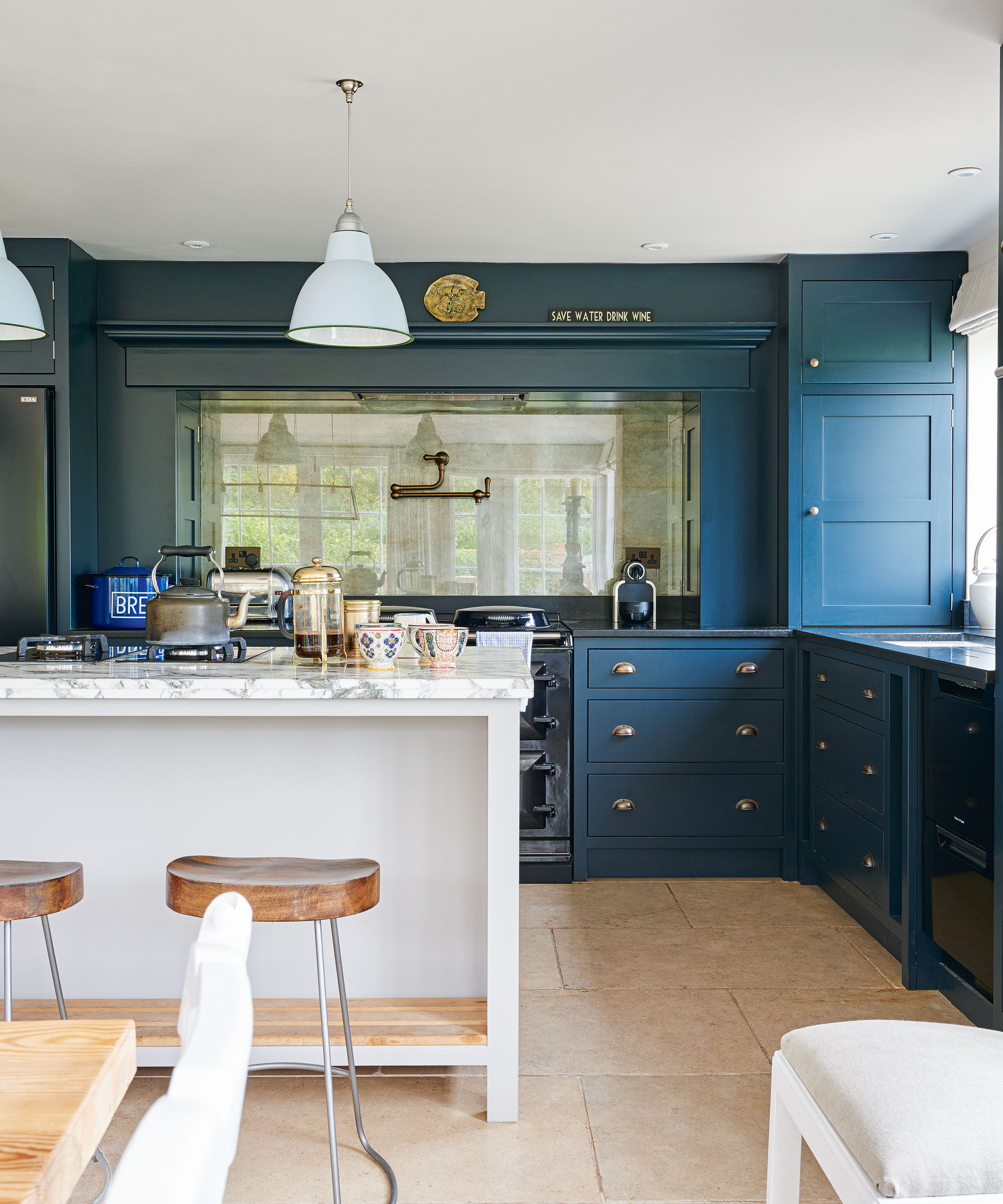
Photography/Jonathan Gooch
With metals so popular in lighting, it can be easy to forget about how impactful using a traditional material can be.
Depending on the style of your home, classic enamel pendant lights can offer a retro, rustic or industrial feel. It's a look that works especially well in barn conversions, country properties and spaces with exposed brick walls, as well as being a great choice when it comes to lighting ideas for small kitchens.
16. Opt for a cluster
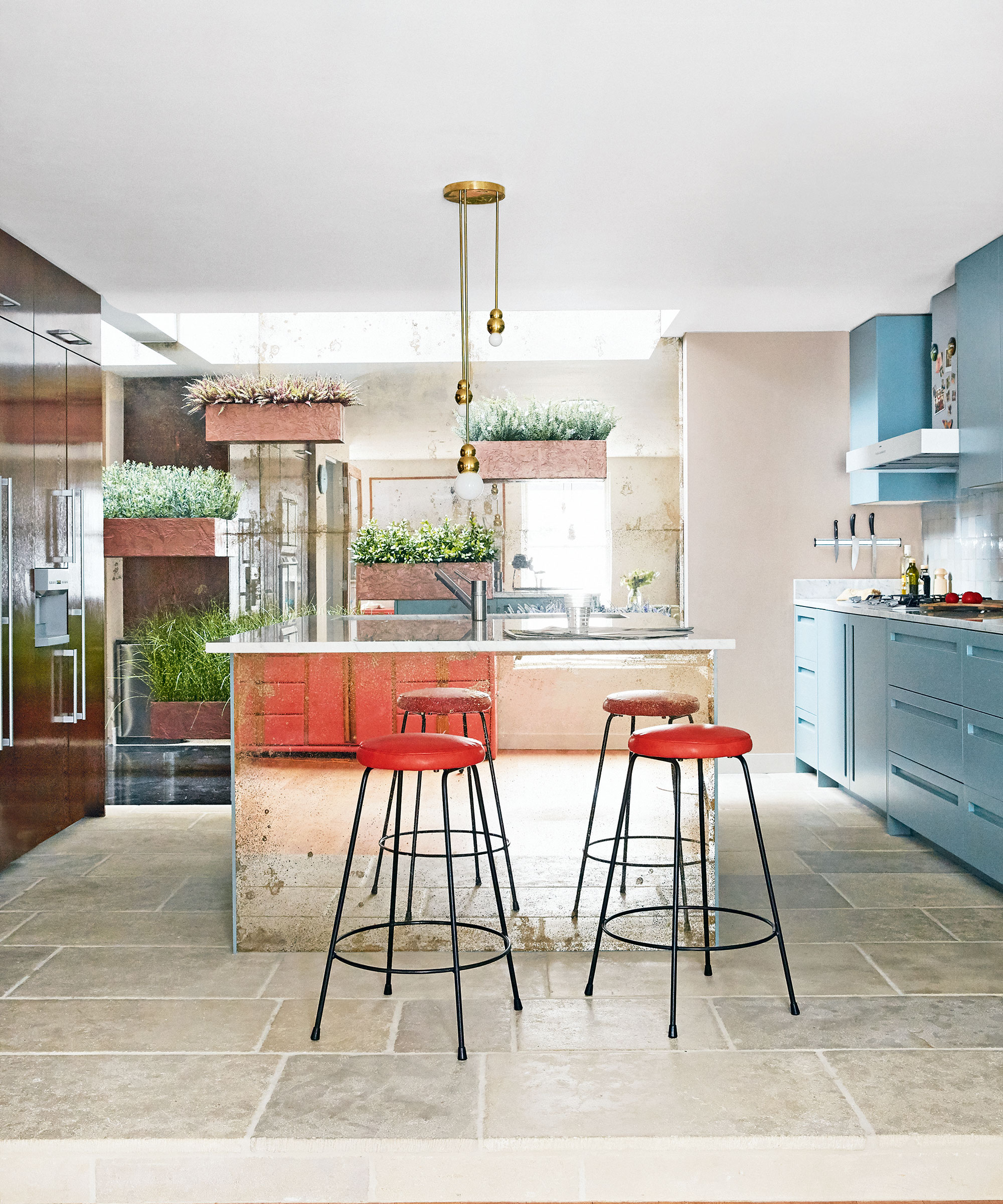
Photography/Paul Massey
Perfect for people who want the traditional single pendant look but still want to maximize light are cluster ceiling lights.
Many versions of these can be adjusted length-wise, so you can play around with different heights and arrangements to fit with a whole host of traditional and modern kitchen island ideas.
This bespoke mirrored island by Jo Berryman Studio clearly wants to be the star of the show, and this is a wonderful way to show the power of kitchen island lighting.
Sam Neuman, founder of Home Lighting Ideas says, 'The kitchen island is the centerpiece of the kitchen, and the lighting allows you to celebrate and enhance this design feature.'
17. Add a highlight

Photography/Davide Lovatti
Keeping to a strict monochrome look in your kitchen is a great way for making a strong design statement. This doesn't mean, however, that you can't add unexpected splashes of something special.
This row of three seemingly simple black pendants have added interest with their insides being brass. Not only does this align with the subtle brass detailing on the cabinetry and faucets, but it actually adds a wonderful warmth to the light these pendants produce, and therefore the overall scheme.
18. Size up
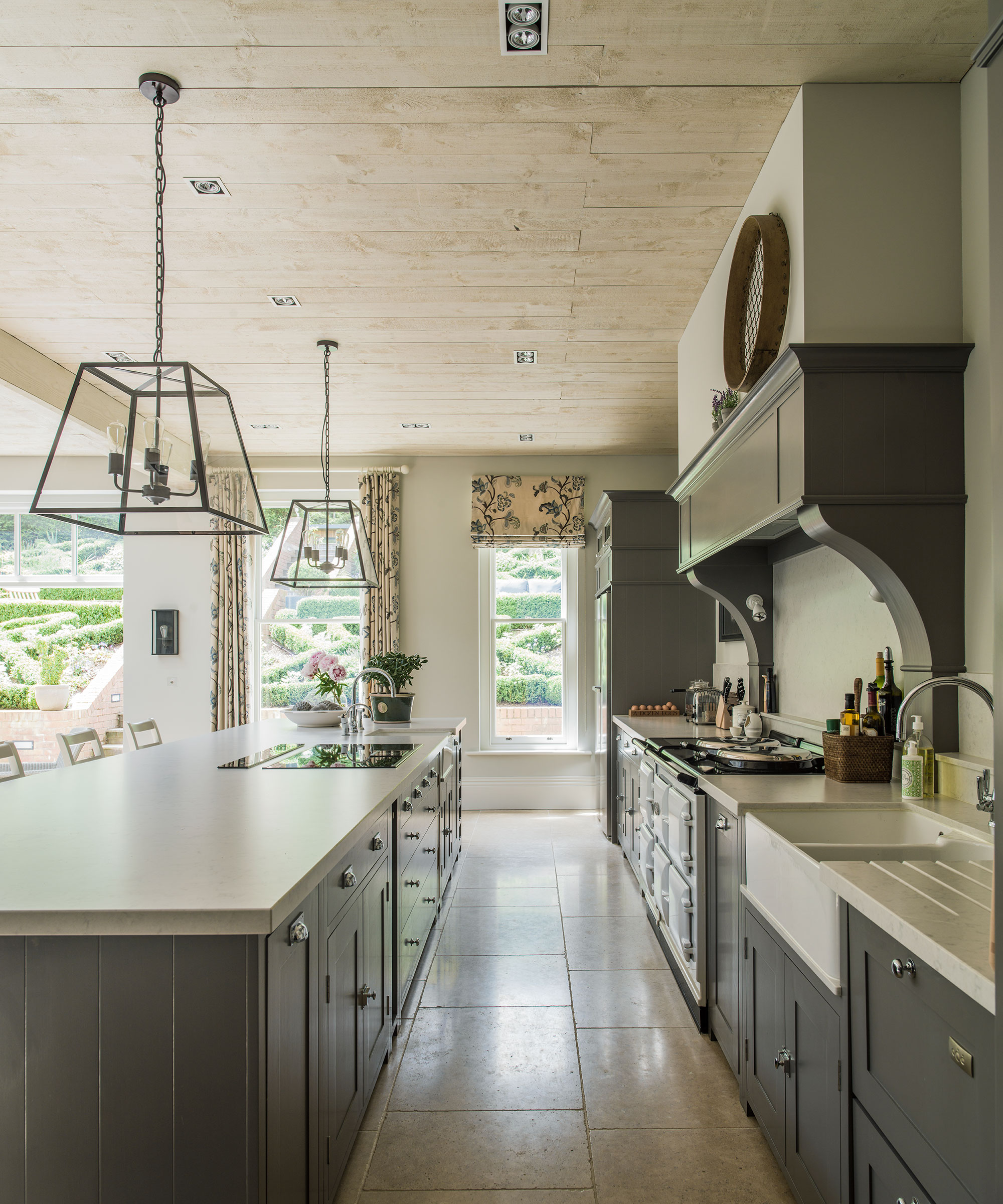
Photography/Mel Yates
Consider your kitchen island size when selecting the right lighting for the space. In a generously sized kitchen your island will also be sized up.
This extra-large island demonstrates the need for a couple of oversized pendants to light up the whole space without overcrowding above. Choosing glass shades stops the lights from overpowering, too.
19. Big up the bulb
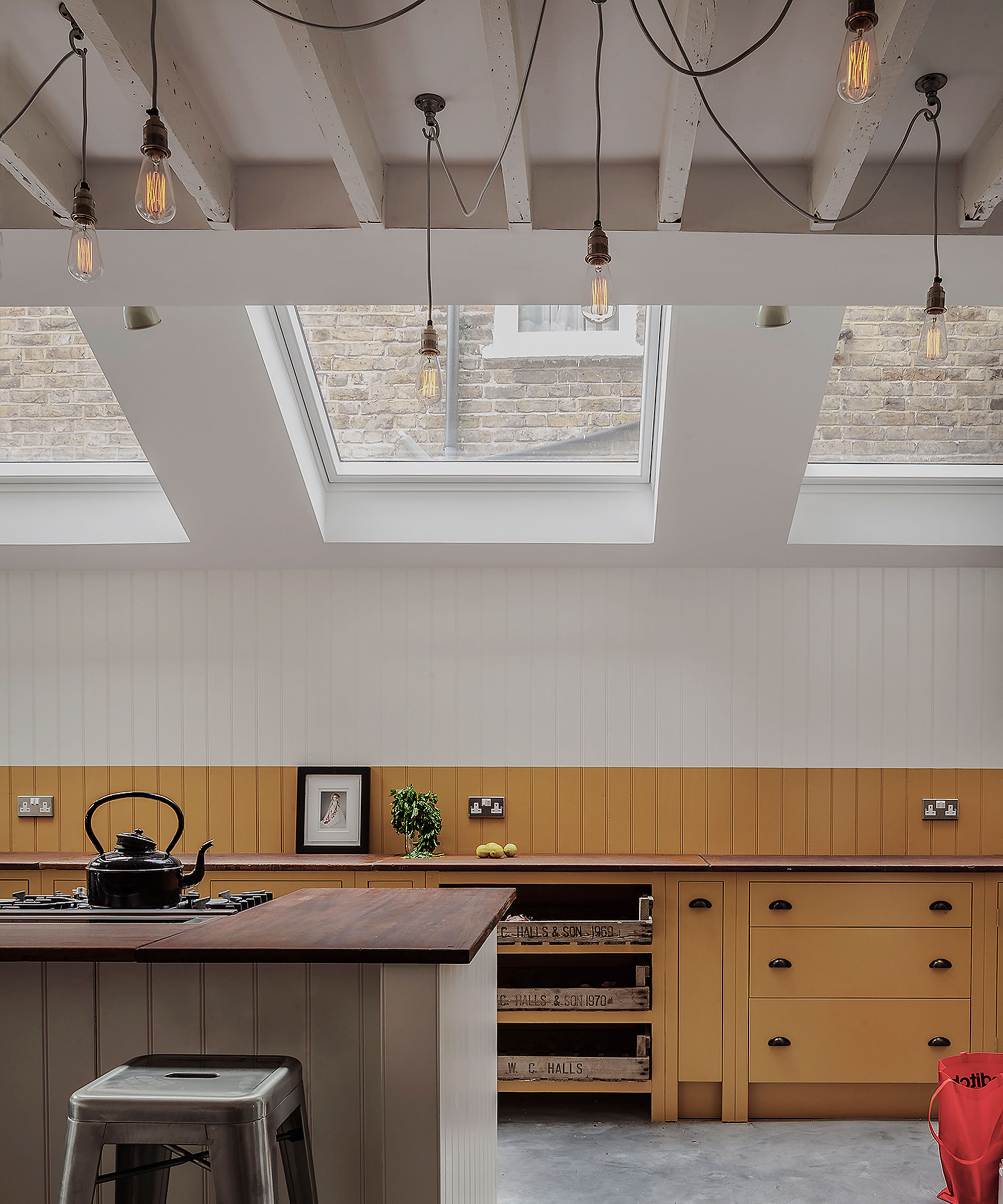
'Filament or Edison bulbs have grown in popularity over recent years, as a reaction to the harsh and unflattering quality of most low energy lighting,' notes Adrian Bergman, design manager, British Standard by Plain English. 'Filament bulbs provide a warm light and look great with braided cables and vintage or industrial type fittings.'
Use ceiling hooks to loop up cords to create your own kitchen island lighting design, and one that can be easily changed depending on whatever atmosphere you wish to create.
20. Be as bold as brass

An angular kitchen island lighting fitting can be the perfect addition to a modern kitchen.
In this contemporary space, the use of this brushed brass pendant is a wonderfully joyous addition. It also picks up the tones in the beautiful marble kitchen backsplash and countertops.
How do you pick a light for a kitchen island?
To pick a light for a kitchen island, it's important to think about the light itself.
'Use good quality lamps in the kitchen, with 90+ CRI (color rendering index) to complement food and to make you feel good,' advises Sam Neuman. '2700K is flattering and dims well.’
'For breakfast, ramp those lights up to full spectrum white, also ensure your walls are well lit, especially if it’s a gray day,' continues Sam. 'To combat dullness, feed the retina with light to help align the circadian rhythm to daytime conditions.
'In the evening, change to a relaxed atmosphere using warm tungsten color light (2700 to 2200K), allowing melatonin to be released in the brain, to relax and prepare for sleep.'
There are practical considerations, too. ‘It is important to make sure that lighting has the ceiling support it needs,’ says Richard Moore, design director at Martin Moore. ‘The larger and more dramatic your pendants are, the more weight will be needed to support them.
‘It is crucial that lights be fixed to a wooden joist above the ceiling; if a kitchen has very high ceilings, it is a good idea to introduce a suspension bar. Not only will this help break up the space between the ceiling and the island, but it also allows for several pendant lights to be wired up to one source.’
How many lights should be on a kitchen island?
When designing a kitchen island lighting scheme, the number of lights you will need depends on the size of the piece as well as the light itself.
That said, if in doubt remember that odd numbers are more pleasing on the eye, so in a larger island consider three rather than four.
What is trending in kitchen island lighting?
If you've decided to take the plunge, perhaps you want to know what's trending in kitchen lighting?
'Pendants are an island’s best friend,' notes lighting designer Sam Neuman. 'Once dimmed low, they throw a soft light all around, creating a flattering ambience while taking the focus away from the cooking clutter.
'Downlights are ideal for highlighting the sculptural form and surfaces of your kitchen island. Use multiple circuits for maximum effect.'
Ultimately, the most important thing to consider is what you want your kitchen to offer.

Thea Babington-Stitt is a Content Editor at Future. She has been an interiors journalist for nearly 10 years and has held positions at LivingEtc, Country Homes & Interiors and Homes & Gardens. Currently, she is writing for Ideal Home and Style At Home's websites and magazines.
- Lara SargentContributing Editor